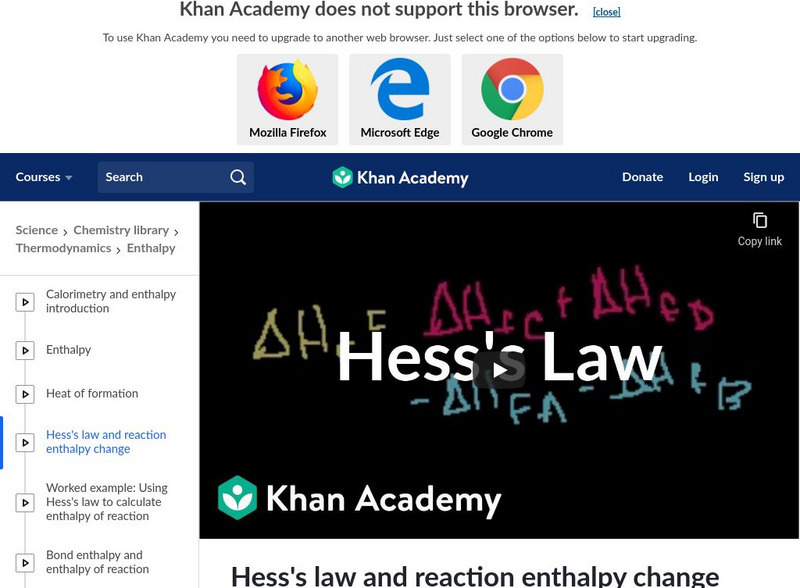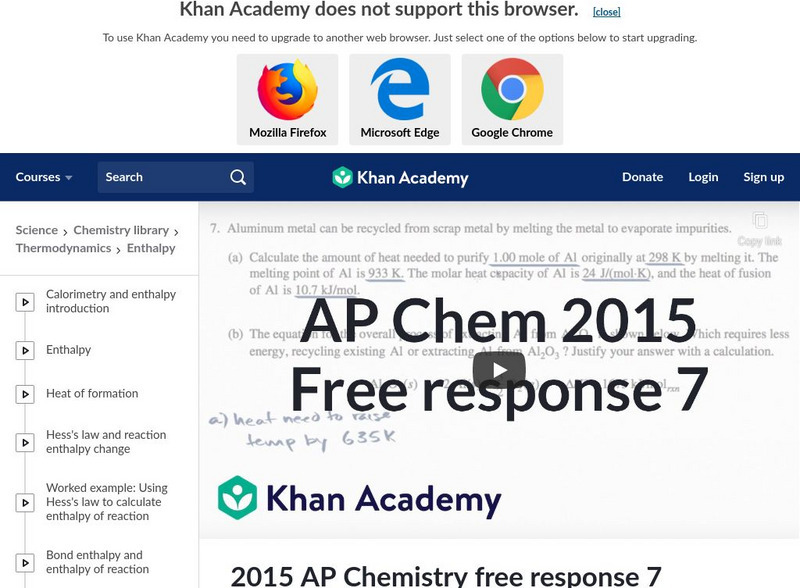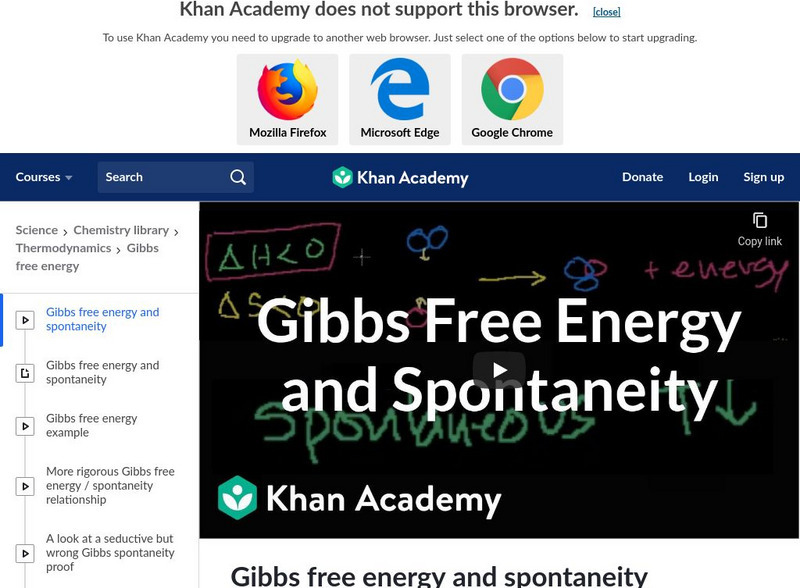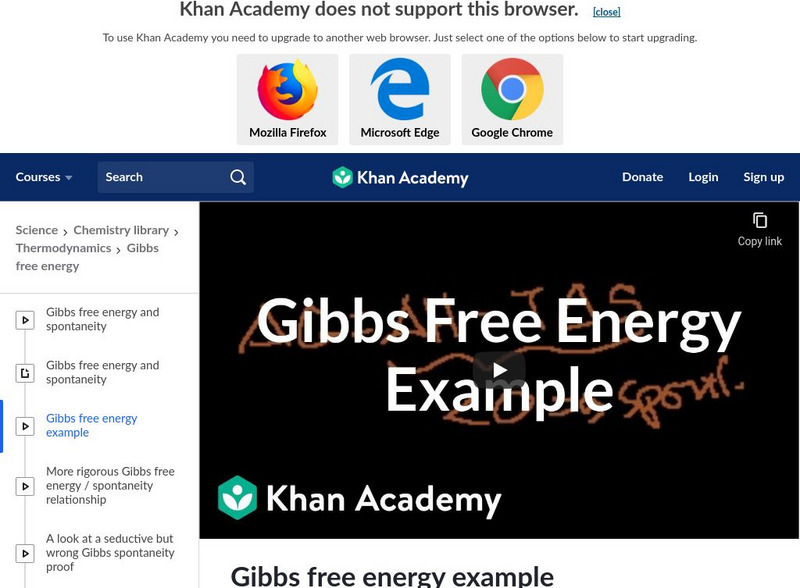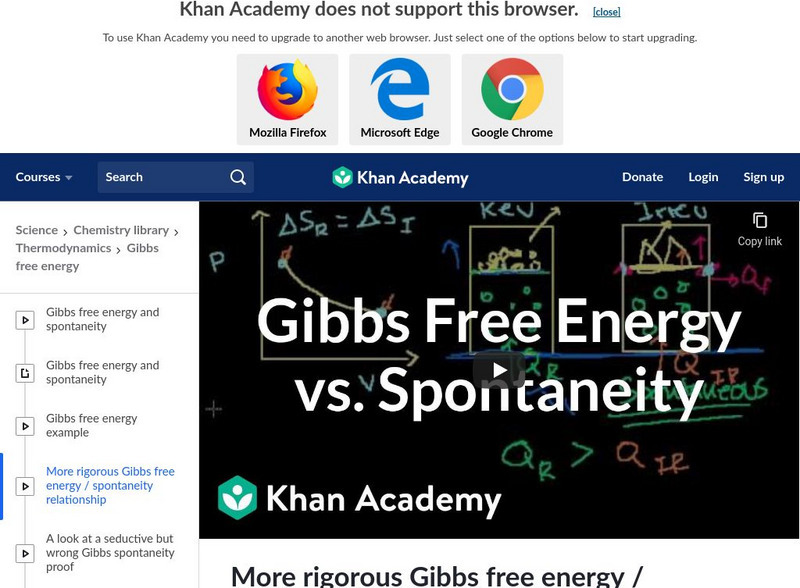Khan Academy
Enthalpy, Thermodynamics, Chemistry
Sal introduces students to the term "enthalpy" in this chemistry video. He defines enthalpy as: the internal energy, plus the pressure times the volume found in a system. He constructs a PV diagram to illustrate this point.
JFR Science
Hess' Law: Enthalpies of Formation
Tired of long, tedious enthalpy calculations? Look no further than Hess' Law! Young chemists discover a shortcut using changes in enthalpy with a video from JFR Science. The narrator talks about the theory behind the law, then performs...
Socratica
Chemistry: Ionic Bonds vs Covalent Bonds (Which is Stronger?)
Both ionic and covalent bonds present as strong bonds, but which is stronger? Socratica presents a video from its chemistry playlist that attempts to answer this question. It addresses how strength is measured and the range of strengths...
Teacher's Pet
Heat in Changes of State
Melting ice seems pretty easy, right? But what's actually happening is much more complex! Introduce the class to enthalpy calculations using a video tutorial. The narrator explains and performs the calculations that show the energy at...
Teacher's Pet
Calorimetry
How do you measure the heat within a substance? Introduce your chemistry scholars to the concept of calorimetry with a short but detailed video. Pupils discover the uses of calorimetry, how to perform calculations using data from a...
Fuse School
Bond Energy and Calculations
Explain the complex concept of bond energies through a comprehensive video lesson. The final lesson in a 35-part series defines bond enthalpy and then leads scholars through several calculations. Each example increases in complexity,...
Crash Course
Calorimetry
When the chemists who designed hand warmers were working, they had to consider how much heat they could give off to keep people warm — and not burn anyone in the process. How is this heat given off in a chemical reaction measured?...
Crash Course
Enthalpy
Where does the heat come from in hand warmers? Learn about enthalpy, the change in energy in a system, to see that when chemical bonds are broken or formed, energy moves into and out of a system because of chemical reactions.
TED-Ed
What Triggers a Chemical Reaction?
Chemical reactions are happening all around us every second of every day, but what exactly causes these changes to occur? Using easy-to-understand analogies, this video explains how the concepts of enthalpy and entropy determine the ways...
Educreations
Entropy & Free Energy
An understanding of chemical reactions really boils down to two concepts: entropy and enthalpy. Follow along with this instructional video as it explains how these two principles are used to calculate Gibbs free-energy which...
Khan Academy
Khan Academy: Energy and Enzymes: Gibbs Free Energy and Spontaneous Reactions
This video lecture will show use how to use the Gibbs Free Energy equation to predict whether a reaction is going be spontaneous or not. [9:17]
Khan Academy
Khan Academy: Calorimetry and Enthalpy Introduction
An explanation of enthalpy. [11:06]
Khan Academy
Khan Academy: Enthalpy
An explanation of how enthalpy in a constant pressure system can be considered heat content. [15:07]
Khan Academy
Khan Academy: Hess's Law and Reaction Enthalpy Change
Using Hess's Law and standard heats of formation to determine the enthalpy change for reactions. [15:40]
Khan Academy
Khan Academy: Bond Enthalpy and Enthalpy of Reaction
An explanation of using bond enthalpy to calculate enthalpy of reaction. [11:47]
Khan Academy
Khan Academy: 2015 Ap Chemistry Free Response 7
Calculating the necessary energy to recycle aluminum from aluminum oxide which was a question on the 2015 AP Chemistry exam. [6:16]
Khan Academy
Khan Academy: Gibbs Free Energy and Spontaneity
Introduction to Gibbs free energy. Includes information about the relationship between spontaneity and entropy, enthalpy, and temperature. [17:40]
Khan Academy
Khan Academy: Gibbs Free Energy Example
Calculating change in Gibb's free energy to identify whether or not a reaction is spontaneous. [9:56]
Khan Academy
Khan Academy: More Rigorous Gibbs Free Energy / Spontaneity Relationship
Extended explanation of the effect of a negative charge on Gibbs Free Energy. [13:56]
Khan Academy
Khan Academy: A Look Ar a Seductive but Wrong Gibbs/spontaneity Proof
An explanation why many textbooks are incorrect in their details about the "proof" of the relation between Gibbs free energy state and spontaneity. [6:41]
Khan Academy
Khan Academy: Changes in Free Energy and the Reaction Quotient
An explanation of Gibbs Free Energy and the reaction quotient under conditions that are not standard. [15:47]
Khan Academy
Khan Academy: 2015 Ap Chemistry Free Response 2 C
Explanation of Gibbs free energy and equilibrium constant of dehydration. Example is from the 2015 AP chemistry test. [12:23]
Khan Academy
Khan Academy: Biology: Endergonic, Exergonic, Exothermic, and Endothermic
This video investigates the similarities and differences between endergonic, exergonic, exothermic, and endothermic reactions. [11:51]
Science for Kids
Science Kids: Experiment Video: Creating Instant Hot Ice
How does a hand warmer warm your hands? Find out with this demonstration of the exothermic reaction of water and sodium acetate in action. [2:24]













